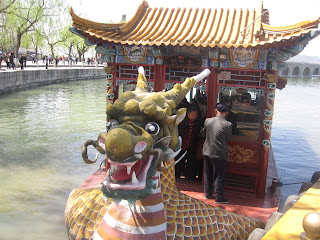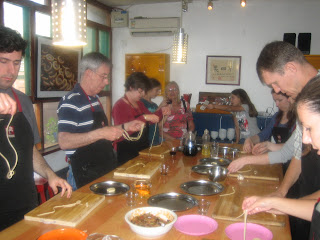1,129 miles + $1,000= one squirming, watermelon-eating baby panda.

We arrived in Chengdu on Wednesday evening and were driven to our hostel, the Lazy Bones, by a pick-up service. This place was pretty cool. We got a nice ensuite double for about $20/night, and arranged to leave early the next morning with a tour group to the Chengdu Panda Research Center, about 10km out of town.

Tea in the hostel
When we arrived, our non-English speaking tour guide led us on a romp through the confusing labryinth of the center in order to see the best parts of the reserve. We managed to make it to several enclosures to see feeding time, which was kind of fun. Of course, any other time we've seen pandas in a zoo they've been eating bamboo, so this wasn't exactly new to us (pandas must eat 20-30kg of bamboo a day!). After strolling around for a few hours, our guide finally led us to the highlight of our trip: Panda holding.
For about $150/each, Andrew and I put on hospital gowns, gloves, and booties and patiently waited our turn to hold a baby panda. The first panda they brought out was a little fidgety, so they swapped him out for a different one who was quite happy to sit on our laps and eat some watermelon.




We only got to spend a few minutes with the panda, and it was difficult to pet them while wearing gloves (we tried tearing holes in them but they were too thick) so I used my face to feel their fur! They surprisingly didn't smell bad and their fur was pretty thick and soft. Andrew swears his panda winked at him.
I'm really glad that this center takes so many precautions to protect the pandas. They only allow a certain number of visitors to hold them each day, and everyone, including Jackie Chan, has to wear gloves and gowns. Also, they don't allow anyone to spend too long with them, and they don't allow anyone other than paying visitors to be in the room with the baby. This was disappointing for one girl there, as her non-paying boyfriend wasn't allowed to go into the room with her. Thankfully, the staff was happy to take as many pictures as we wanted. And we got a free mousepad!
After our experience, we rejoined the rest of our group and went to the museum on-site. This museum was crazy weird. It focused on the reproduction of pandas, and included lots of graphic pictures of panda genitals, which seems weird coming from censorship-crazy China. After this, our group departed for the hostel, but we decided to stay an additional three hours and walk around the rest of the park.




We got to see more red pandas close up, and even witness some baby pandas playing with each other. We had a good time just watching them play and eat and sleep. There were guards at every enclosure to make sure no one tried to feed the pandas or spoke too loudly. However, there was on red panda enclosure out of the way, which was unguarded, and we took that opportunity to be a little naughty. Here, the wall was pretty low, and the red pandas came very close to us, obviously looking for food. Despite our better judgment, we hand-fed them little pieces of Fig Newtons (hey, at least it wasn't a steak or a Snickers bar, OK?). Andrew even pet them a little! These guys are cuter than regular pandas, I think.


We found out some interesting information about pandas while there. Apparently there are less than 1,000 left in the wild, mostly due to deforestation of bamboo-a-licious areas in China, but a major contributing factor to their demise is evolution. These pandas are not meant to survive. The males have evolved very tiny penises, and the females very long vaginas, making reproduction a tricky endeavor for them. If the female is lucky enough to conceive, she ALWAYS gives birth to a premature cub that she immediately tries to kill. In addition, despite the 30 odd varieties of bamboo which exist, pandas are very picky and will only eat three or four types. As bears, they should have a pretty varied diet, but for some reason refuse to eat anything but the energy-inefficient bamboo. So overall, these guys are destined to go the way of the dodo, which is sad. You can watch them play here:
At the park, we heard, but never actually saw, what we assume were ducks taking a bath. It sounded like someone was drowning Daffy Duck. It was hilarious and never ceased to make us giggle everytime we heard it. Have a listen!
When we'd had our panda fill, we returned to Chengdu and walked around the city a little. I stopped by Starbucks for some coffee, and we hit up a bookstore for a National Geographic magazine. One of the most exciting things about this city trip was that we found a vendor selling a type of berry that I distinctly remember eating as a child because they grew in my backyard in San Bernardino. This prompted an argument between me and Andrew, with me insisting that they were blackberries and Andrew adamantly disagreeing. He insists they were too long, the berries too small, and that they shouldn't grow on trees, as they did in my backyard. After looking them up online, it seems that I was correct, but Andrew isn't 100% convinced. Mom, do you remember what those berries were called?

OK, sorry for the digression. After our walk-about, we decided to brave Sichuanese cooking, seeing as how we were in the capital of Sichuan, afterall. Any of you who have ever eaten Szechwan food at a Chinese restaurant in the states probably know that it's SPICY. So we of course had to try it out and see just how spicy it was. The first thing we ordered was a tofu dish, that was VERY spicy. Even a jug of almond soy milk couldn't quite quench the fire. Then we moved onto to kung pao chicken, which many of you probably know. Surprisingly, this wasn't too spicy, but it could have just been that our mouths were numb after the tofu. We tried some other dishes, including dan dan noodles, and overall really enjoyed our dining experience. But probably the best thing we ate in Chengdu was this round, sesame-covered fried flat-bread stuffed with ground beef. It was heavenly.

After dinner, we walked to the local park, hoping to get Andrew's ears cleaned (apparently it's the thing to do in Chengdu) and visit a local tea house, but we arrived too late. Everything was closed down for the night. A little disappointed, we went back to the hostel and packed all our acquired wares for the flight back to Beijing.
All in all, we spent a little more than 24 hours in Chengdu, but I think someday we will go back. If the pandas are still alive, we'll take our kids to hold them, and hopefully make it back to the ear-cleaner. Afterall, Andrew's ears are pretty dirty!















































